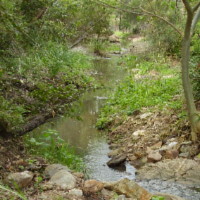
- Go Veg for the Planet
- Arup's Michael Velders, Senior
Sustainability Consultant, leads
Arup's Centre of Excellence in Food and Agriculture. They now
have
clients on 6 continents asking them to work on urban agriculture
systems, to build resilience into food supply. Why food? Why food
and carbon?
- 60million meals/day from farmers' paddocks to our plates
- 30% of carbon emissions are food-related (vs 20% for transport)
- 95% of food is oil-related (agrochemicals, heating, cooling,
lighting, fertiliser, transport)
- price index of oil relates directly to price of food. If price of
oil doubles, price of food doubles
- If we want to have a future we have to disconnect food from oil
- The ecological footprint of food is 48.8% of total (compared to
goods & services 35.1%, transport 3.2%, household use 7.0%,
construction & renovation 5.9%)
- Peak Phosphate - world rock phosphate production has peaked
globally only 20-30 years' supply left, and 40% is in China, and "they
ain't selling!!!"
- Peak Potable Water - agriculture uses 65% (compared to household
use 12%, industry 18%, manufacturing 3%, mining 2%)
- Peak Farmers - average age of Australian farmers is 62 years
- Q. How to make food production an integral part of the city?
- Q. How to use sewerage (human manure) to provide the desperately
needed supply of phosphates for future food production?
- Q. How to develop closed cycles of production where water and
nutrients are returned to the system and the energy used by the system
produced by the system
- We need to access waste water, nutrients, markets, research
centres.
- Why would South-East Queensland go for Urban Agriculture?
- Water availability already an extreme concern
- Nutrient sources already a concern
- LVO Architecture's Nick McGowan has a travel bursary taking him
overseas looking at Food Sensitive Urban Design - reintegrating food
production into our cities.
- Q. Which models and methods of Urban Agriculture might be best
suited to Brisbane?
- Globally we are running out of land where we can produce food. It
is time to start getting serious about rethinking our food systems.
- Urban Agriculture has been around since ancient Persian, ancient
China and Peru. There are more than 40 types of Urban Agriculture
systems around the world, and about 800 million urban farmers producing
15% of the world's food.
- Urban Agriculture is a catalyst for urban regeneration, reduces
criminal activity, improves people's physical health, and allow
ecosystems to be rehabilitated.
- Some successful Urban Agriculture models are:
- Decentralized urban farming networks, where a business contracts
to set up and farm vegetables in people's backyards. Resident gets some
produce. Costs about $30-$50 to set up, and lots of 40-100 square
metres are needed to be tenable. Urban farmers would typically manage a
number of backyards.
- Allotment gardens
- Temporary gardens in large moveable sack/containers
- Community farms and farm subdivisions (Ex. Currumbin Ecovillage)
- Public open space farming (Ex. Hampstead Common proposed for West
End)
- Vertical Farms - 5 story $30million, 30 story $200million. They
look like high rises, and are closed systems, vertical greenhouses,
hydroponics, aeroponics, utilizing local waste, grey and black water as
fertiliser, allowing degraded farmland to return to nature. One could
feed 50,000 people. We'd need about 40 to feed Brisbane. Architects are
bursting with creativity designing them.
- Resource Centre on Urban
Agriculture and Forestry (RUAP)
- The Urban
Agriculture Network (TUAN)
- UN Habitat
- Vertical Farm Information
- Thought for the day: It might be a huge challenge adapting and
transitioning to local food resilience, but it is not our problem
whether the big supermarket chains manage to adapt and transition.
However, integrated food and agriculture proposals are already being
developed for shopping centres.
- A big part of "food miles" is the transport we all do to and from
supermarkets to buy our groceries.
- Moreton Water Resource Plan will provide for no more water for
new agricultural projects. If you want to put in a new agricultural
system, you'll have to find a new source of water.
- The big food basins on the world largely rely on glacial
melt-water, and the glaciers are retreating very rapidly. Consider the
food basins of China, India, Egypt, California, Europe and South
America.
- Local Food &
Community Gardens
- Northey
Street City Farm
- Brisbane
Local Food
- Brisbane Organic
Growers Inc (BOGI)
- Samford
Local Growers
- Growing
Communities
- Food Connect
- Soil
Carbon Sequestration
- Carbon farming and humates
Back To Top
This page last updated
- The Vision
- What's On
- Portfolios
- Heart &
Soul >
- Churches
- Events,
Celebrations, Parties, Dancing
- Halls,
Meeting Rooms, Auditoriums
- Restaurants, Cafes, Bars
- Serving
& Volunteering
- History,
Local Residents' Stories
- Music,
Art, Theatre, Poetry, Ballet
- Sports,
Martial Arts, Walking, Cycling
- Clubs
& Interest Groups
- Picnic
Grounds, Playgrounds, Camping
- Museums,
Art Galleries & Zoos
- Libraries,
Resource Centres, Book Clubs
- Community
Classes & Coaching
- Birdwatching
- Pet
& Animal Facilities
- Markets,
Op Shops
- Young,
Seniors, People with Disabilities
- Languages,
Writing
- Food >
- Transport >
- Healthcare >
- Education >
- Local Business
& Economy >
- Governance &
Leadership >
- Water Resources >
- Local
Facilities >
- Security >
- Waste Management
- Environment
- Energy
- Manufacturing
- Equipment
& Skills
- Mining &
Forestry
- Civilisation &
Ideas
- Statistics
- Science, Reports & Videos
- Making a Difference
- Communication